When exploring authentic Austrian cuisine, few experiences rival the simple pleasure of enjoying Rosamunde's famous Pöllinger sausage at its original Vienna location. This isn't merely another bratwurst or frankfurter—it's a culinary institution with over 160 years of history. Understanding what makes this particular sausage special requires examining its unique preparation, cultural significance, and the specific context of where it's served.
The Origin Story of Rosamunde Sausage
The Rosamunde Schanigarten (originally called Rosamunde Pöllinger) began as a modest grillhouse in Vienna's 9th district in 1860. Unlike traditional Austrian sausages with regional variations across the country, Rosamunde's signature sausage developed its fame through consistent preparation at this single establishment. The name "Pöllinger" comes from the original owner's surname, not from any specific sausage-making technique or regional style.
What distinguishes Rosamunde sausage from other Austrian varieties is its preparation method. While most Viennese sausages are boiled then briefly grilled, Rosamunde's Pöllinger undergoes a slow grilling process over beechwood charcoal, creating a distinctive smoky flavor and crispy exterior that has become its trademark. This preparation method, unchanged for generations, transforms simple ingredients into something extraordinary.
Ingredients and Preparation: What Makes It Unique
Despite its legendary status, Rosamunde sausage maintains a remarkably straightforward ingredient profile:
| Component | Details |
|---|---|
| Primary Meats | Beef and pork in traditional Austrian sausage ratios |
| Seasonings | Simple blend of salt, pepper, and traditional spices (no proprietary secret formula) |
| Casing | Natural肠 casing providing that characteristic snap |
| Preparation | Slow-grilled over beechwood charcoal (key differentiator) |
The magic happens during cooking. While most Austrian sausages like Frankfurter or Burenwurst are primarily boiled, Rosamunde's Pöllinger spends significant time over the grill, developing complex Maillard reaction flavors that transform the simple meat mixture. The beechwood charcoal imparts subtle smokiness without overwhelming the natural meat flavors—a delicate balance achieved through generations of experience.
Traditional Serving Style and Pairings
Authentic Rosamunde sausage experience follows a specific presentation that's become standardized through decades of tradition:
- Served on a simple wooden board (never a plate)
- Accompanied by generous portions of house-made sauerkraut
- Three types of mustard provided: sweet, spicy, and traditional
- Always includes a half-loaf of crusty bread for soaking up juices
- Traditionally enjoyed with a glass of local beer or white wine
This serving style reflects Viennese Schanigarten culture—outdoor dining spaces that bloom in spring and summer. The simplicity of the presentation highlights the sausage itself, allowing diners to appreciate the quality of ingredients and preparation without distraction.
Where to Find Authentic Rosamunde Sausage
Despite its fame, authentic Rosamunde sausage remains geographically limited. The original location at Neustift am Walde 960 in Vienna's 19th district remains the only place to experience the genuine article prepared according to tradition. While some specialty butchers may offer "Rosamunde-style" sausages, these lack the specific preparation method and context that define the authentic experience.
Travelers seeking the genuine Rosamunde sausage experience should note:
- The establishment operates seasonally (typically April-October)
- No reservations accepted—dining is first-come, first-served
- Cash only payment system maintains traditional atmosphere
- Expect wait times during peak season, part of the authentic experience
Cooking with Rosamunde-Style Sausage at Home
While replicating the exact Rosamunde experience at home presents challenges, you can create a satisfying approximation. The key elements to focus on when preparing Rosamunde-style sausage include:
- Charcoal selection: Use beechwood charcoal if possible, as it provides the clean, subtle smoke characteristic of the original
- Slow cooking: Grill over medium-low heat for 15-20 minutes, turning frequently
- Sauerkraut preparation: Simmer with caraway seeds, a touch of sugar, and apple slices for authentic flavor
- Mustard selection: Offer multiple varieties to allow customization of flavor profile
For those seeking traditional Austrian Rosamunde sausage cooking techniques, remember that patience is essential—the slow grilling process develops flavors that quick cooking cannot replicate. The best results come from treating the sausage gently, avoiding high heat that might cause bursting or uneven cooking.
Preserving the Tradition
The enduring popularity of Rosamunde sausage demonstrates how a simple food preparation can become cultural heritage. Unlike mass-produced sausages with standardized recipes, Rosamunde's appeal lies in its consistency within a specific context—maintaining the same preparation methods while the world around it changes.
When enjoying Rosamunde sausage, whether at the original Vienna location or attempting a home approximation, you're participating in a living culinary tradition. The experience transcends mere sustenance, connecting diners with Viennese Schanigarten culture and the simple pleasure of well-prepared food shared in good company.











 浙公网安备
33010002000092号
浙公网安备
33010002000092号 浙B2-20120091-4
浙B2-20120091-4